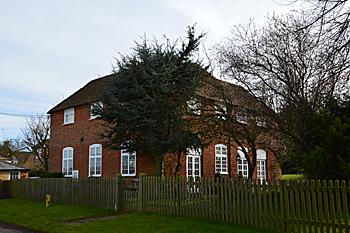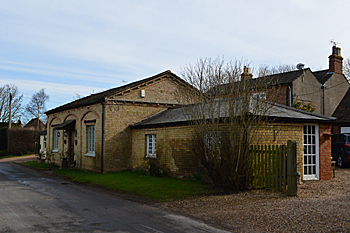Brook End Baptist Chapel Keysoe

The Old Chapel House March 2016
The nonconformist meeting at Keysoe Brook End dates from 1652. Though the first church book has failed to survive the second book, held, like all the early records, by Angus Library, Regents Park College, Pusey Street, Oxford has a summary of the early history. One of the meeting’s earliest leaders was nominally an Anglican clergyman, John Donne (not the poet of the same name who was incumbent of the parish church at Blunham); he was Rector of Pertenhall from 1653 until 1660. He was of the type of early nonconformist known as an Independent; John Bunyan was another such independent.
The independent church at Keysoe grew slowly but steadily, the church book telling us that the following members were added at the following times:
- four in 1658;
- five in 1659;
- eleven in 1660;
- five in 1662;
- four in 1663.
That indefatigable Baptist historian for Bedfordshire, the late H G Tibbutt published a short history of the Baptist churches in Keysoe in 1959. A copy is available in the Bedfordshire Archive and Record Service searchroom. He highlights two rules for membership agreed upon in 1658 :
- “that all our Friends shall have notice of the names of such as desire admittance, some time before the monthly meetings”;
- “in case they be in any way dissatisfied as to their admittance they shall either be present to shew it to the church, or if other occasions hinder, then they shall signify their dissatisfaction by writing or otherwise, to the society, with the grounds of it”.
When Charles II was restored to the throne in 1660 John Donne was ejected as Rector of Pertenhall and devoted himself full-time to Keysoe. At some point he was imprisoned, a fate shared by John Bunyan, indeed they seem to have both been in Bedford gaol at the same time. Both were released following passing of the Declaration of Indulgence in 1672. This act allowed for nonconformists to register meeting houses and meet there legally. The houses of George Fowler, John Donne and Thomas Richards in Keysoe were all registered by the independent congregation in May 1672.
John Donne died in August 1678 and details of the history of the cause in Keysoe are few until the surviving church book begins in 1790. The pastor from 1725 to 1746 was Samuel Cole and he was buried at the meeting yard in Brook End. The epitaph on his tomb read:
“Inclos’d within this tomb Dear Cole doth lie,
Whose dust is watch’s by Christ’s auspicious eye,
Until the last loud Trump shall blow and sound,
To wake the nations bury’d under ground;
Then shall he rise, array’s in glory bright,
Shining in gems from Christ, the source of light,
Sitting with him, shall judge the impious race,
Who slighted and contemn’d his gospel grace”.
In 1741 the present meeting was built, replacing the one in use since 1652. It is built of red brick, with brick dressings and clay roof tiles. It is square in plan with a small single-storey projection to the south-east. Title deeds from 1853 to 1925 are at Church House, London
Until 1766 the Brook End congregation remained an independent meeting, without specific Baptist tenets (often referred to as Anabaptists by Anglican clergy of the period). In that year William Dickins became pastor. He was well-known locally for his grandfather having fallen from the spire of Keysoe church and survived the experience. It was he who quickly changed the character of the meeting to that of a Baptist creed. On May 21st it was “agreed at our Church Meeting as We Believe the ordinance of baptism to be a [sic] ordinance of Christ, We agree to give one another Liberty Respecting Mode and Subject” but clearly only adult baptism was to be practised.
Being a Baptist was tough. One stood in danger, along with other nonconformists, of persecution from any church-going majority, whilst being judgemental of one's fellow congregation. For example: “Thomas Hopkins was separated by the church 17 November 1776 for his evil practises of an immoral nature, such as not bridling his Tongue and not paying a regard to the Lord’s Day and for gambling and scandalising of persons, which are contary to our Covenant above written”. One could be forgiven if one mended one’s ways: “Elizabeth Willmate (formerly Rennalds) admonished 1774, 1775, 1776, was forgiven and restored to her place February 1777 to our great satisfaction, after a long backsliding of heart and Life for 4 or 5 years”.
Dickins’ successor was James Ward, pastor from 1799 to 1801. Clearly, he was not a success, the church book saying of him: “In doctrinal points we were pretty well agreed but in Mr Ward there was an evident want of candour towards those who differed from us in sentiment. The consequence was that our friends in general became less fond of him and instead of strengthening, he weakened his own and our hands”.
Brook End meeting was, inevitably, affected by the creation of a new Baptist meeting at Keysoe Row in 1812. Numbers of new members fell off. The chapel at Brook End remained an “mixed communion”, that is, members were admitted either after adult baptism or after a profession of faith. As we have seen, this did not prevent discipline being strict.
An entry in the church boor for 1835, however, showed there were problems, being: “at variance one with another for some length of time, on account of which they could not have communion one with another”. A special meeting was held that year: “to reconcile our members and to restore peace and unity in our Church”. Evidently it was not successful. An entry for 1837 tells us that the pastor, who had “laboured amongst us a few years the Church and congregation decreased, which caused him much grief of mind and after making it a matter of prayer to God, he thought it his duty to resign”.
The following year, on 22 June 1838, the meeting was registered for marriages. During the 19th century the Sunday school room (now a private house) was built, from gault brick with a slate roof (now partially tiled). It comprises a single storey.
On the last Sunday in March, 1851 a census survey was carried out of all places of worship in the kingdom. The “Particular and Calvinistic Baptist” meeting at Brook End, with 400 free seats, had a general congregation of 89 in the morning, 195 in the afternoon and 70 in the evening. Sunday scholars were 73 in the morning, 78 in the afternoon and 12 in the evening. The minister, Thomas Gate, wrote: “The present Meeting house was erected in the year 1741, but there has been a Congregation of Baptists at Brook End from the year 1652”.
By the 1920s the congregation at Brook End was declining in numbers and in the late 1960s it became clear that it would have to close [X715/23-24]. The manse, called Chapel Cottage, was unfit for human habitation and the family leasing it were rehoused [X715/27]. The chapel evidently closed around 1970 as in 1975 there was a proposal to re-open it temporarily for a harvest festival, though it was felt likely that the Baptist Union were unlikely to agree [X715/29]. The following year it was stated [X715/30] that the pastor, over eighty, had resigned and moved away leaving three or four members, who had decided to move to Keysoe Row meeting.
In the late 1970s the question of the burial ground was raised, with a proposal to level it. The stance of the Baptist Union Corporation was: “if the people in the local area had in the first place supported the church and up-kept the graveyard, the premises would still be open for worship … with regard to the burial ground, it is true to say for many years the village has enjoyed the facility thus provided but here again the local community has made very little attempt to do anything to up-keep this particular area in a tidy condition. I would also like to point out that this is a private burial ground and folk have been buried there without any permission whatever” [X715/31].
A list of pastors drawn up by H G Tibbutt in 1959 was as follows:
- John Donne: to 1678
- Lewis Norman: to 1720
- Benjamin Dawson: 1720?-1725
- Samuel Cole: 1725-1746
- Richard Denny: 1749-1763?
- Francis Bull
- Joshua Kettelby
- William Dickins: 1766-1798
- James Ward: 1799-1801
- William Brown: 1803-1818
- Reynold Hogg: 1819?-1823?
- Henry Bottle: 1823-1832
- Benjamin Medlock: 1832-1837
- Thomas Gate: 1838-1854
- H Edwards: 1855-1868
- Frederick Perkins: 1869-1878?
- W G Coote: 1879-1880
- Theophilus Gillett Head: 1882-1887
- Thomas Varley: 1888-1901
- George Barnes: 1901-1916
- Henry George Stembridge: 1917-1928
- Ernest Charles Bishop: 1929-1938
- Alfred Ernest Wheeley: 1940-1943
- Arthur Henry Dowler: 1944-1949
- Archibald William Smith: 1952;
- William Harris: 1953-1956;
- Frank Melvern Hirst: 1956
Main sources for the meeting are as follows:
- Keysoe Brook End Church Book edited transcript 1790-1901;
- Keysoe Brook End and Keysoe Row Baptist Churches by H G Tibbutt;
- “Keysoe Miracle” Bedfordshire Magazine Volume XVII page 18;
- X715/5: correspondence: 1817-c.1915;
- X715/8: receipts and payments account book: 1832-1871;
- X715/6: meeting poor rate book: 1833-1834;
- Fac91/2 trust deed: 1853;
- X715/7: church meeting minutes: 1878-1880;
- X715/7: church income and expenditure accounts: 1878-1902;
- X715/35: note on the pastorate of George Barnes: 1901-1916;
- X715/32: list of church members: 1901-1947;
- X715/42-43: church minute books: 1901-1949
- X715/1 list of members: 1917-1971;
- Fac92/2 appointment of new trustees: 1925;
- X715/34: Coroner’s Orders for burial of those buried in the graveyard: 1930-1955;
- X715/41: recollections by Arthur Stapleton: c.1941;
- Z514/1: Sunday collections account book: 1943-1974;
- X715/33: list of church members: 1944;
- X715/36: note on the pastorate of A H Dowler: 1944;
- X715/2 church meeting minutes: 1949-1974;
- X715/37: receipts and payments book: 1955-1974;
- X715/3 women’s bright hour minutes: 1961-1971;
- X715/27-28: correspondence regarding Chapel Cottage: 1966-1968;
- X715/37: list of trustees: 1967-1968;
- X715/24: discussion of the fate of the school room: 1968;
- X715/23: solicitors’ advice on sale of the church building: 1969;
- X715/4 correspondence and loose papers: 1971-1972;
- X715/39-40: receipts and payments books: 1971-1975;
- X715/29: proposal to reopen the chapel for a harvest festival: 1975;
- X715/30: the fate of the chapel and its buildings: 1976;
- X715/31: levelling of the burial ground: 1978-1980;
- Z50/69/5-16 interior and exterior photographs: 1979.

Former Baptist Sunday School March 2016